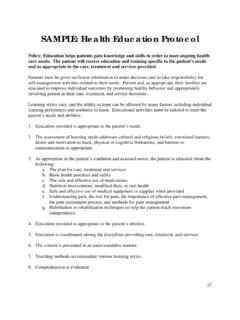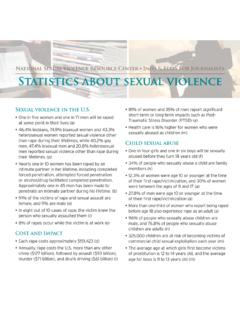Transcription of Providing Inclusive Care for LGBTQ Patients
1 A Resource Guide for Clinical SettingsProviding Inclusive Care for LGBTQ Patients contentsProviding Inclusive Care for LGBTQ Patients1 Introduction 3 Background + statistics LGBTQ Health 101 Data Resources 4 Training LGBTQ Cultural Competence Webinars Clinical Care Webinars Additional Trainings on LGBTQ Health and sexual and Reproductive Health7 Policies + Protocols Non-Discrimination Policies Minor Consent and Confidentiality 8 Intake Forms + Electronic Health Records Sample Intake Forms Electronic Health Records (EHR)9 LGBTQ Inclusive Materials + Events Inclusive Clinic, Outreach and Website Materials LGBTQ -Friendly Provider Directories Minor Consent and Confidentiality Materials Inclusive Healthcare Coverage Materials Prevention Education 12 Clinical Care of LGBTQ Patients Providing Culturally Competent Care Comprehensive sexual History-taking STD/HIV Screening Recommendations PrEP and PEP Evidence-Based Interventions 15 Additional Resources 16 Resources for Youth 18 Appendices.
2 Self-Assessment Tool1 Providing Inclusive Care for LGBTQ Patients Essential Access HealthEssential Access Health champions and promotes quality sexual and reproductive health care for all. Essential Access Health achieves its mission through an umbrella of services including clinic support initiatives, advanced clinical research, provider training, patient education, advocacy and consumer awareness. Essential Access Health funds sexual and reproductive health services for low-income and uninsured clients through nearly 70 health care organizations collectively operating nearly 340 health centers serving more than one million women, men and teens annually in 38 of California s 58 resource toolkit is designed to assist healthcare agencies in meeting the needs of their lesbian, gay, bisexual, transgender and queer ( LGBTQ ) Patients .
3 Approximately four percent of adults in California identify as Among youth aged 15-21 estimates are higher, with seven percent of young men and fourteen percent of young women identifying as gay, lesbian, bisexual, or However, many LGBTQ individuals experience barriers to healthcare access and may delay seeking care out of fear of homophobia, discrimination, and receiving inferior care as a result of their sexual orientation or gender ,5 While the LGBTQ community is diverse, significant health disparities that broadly impact this population have been identified. National studies have demonstrated that LGBTQ youth are more likely than their heterosexual peers to experience harassment and violence at school; more likely to abuse alcohol and drugs; at higher risk for sexually transmitted diseases (STDs), HIV/AIDS, and unplanned pregnancy; less likely to seek preventive health services; more likely to experience homelessness.
4 And 2-3 times more likely to attempt , 7, 8, 9 Among LGBTQ adults, high rates of smoking and substance use, heart disease, stress and mental health disorders, and intimate partner violence have been identified as issues of significant concern. Gay, bisexual, and other men who have sex with men (MSM) are at increased risk for cancers, including prostate, testicular, colon and anal cancers; eating disorders; and STDs/HIV. Lesbian, bisexual, and other women who have sex with women (WSW) are more likely than heterosexual women to be obese, and have higher rates of cancers, including breast and cervical cancers.
5 Transgender women, particularly transgender women of color, experience high rates of physical violence and sexual assault , and extremely high rates of suicidal ideation and , certain sub-populations within the LGBTQ community are disproportionately impacted by HIV/AIDS. While men who have sex with men (MSM) account for only 4% of the male population of the United States, they make up approximately half of all persons living with HIV and two-thirds of new infections Young men who have sex with men (YMSM), particularly black and Latino YMSM, are at highest risk of In recognition of the unique needs of this population, this toolkit highlights several resources that specifically address STD and HIV prevention among MSM, and black and Latino MSM in who are lesbian, gay, bisexual, or transgender (LGBT) are members of every community.
6 They are diverse, come from all walks of life, and include people of all races and ethnicities, all ages, all socioeconomic statuses, and from all parts of the country. The perspectives and needs of LGBT people should be routinely considered in public health efforts to improve the overall health of every person and eliminate health disparities. - Centers for Disease Control and Prevention1introduction 2 Providing Inclusive Care for LGBTQ Patients Essential Access HealthIn order to promote positive healthcare seeking behavior, it is critical that clinics provide Inclusive , culturally competent services to their LGBTQ Patients .
7 In 2014, Essential Access Health conducted a survey of school-based health centers in Los Angeles County. The survey assessed: Agency-wide policies and practices, such as the inclusion of sexual orientation and gender identity in patient non-discrimination policies, and the ability of Patients to identify as LGBTQ in intake forms and electronic health record (EHR) systems; Staff training on culturally competent service provision for LGBTQ Patients ; The physical environment, including the availability of Inclusive educational materials and messages in the clinic setting; and Critical clinical services, including whether providers are familiar with current STD/HIV screening and other health recommendations for LGBTQ Patients .
8 Several gaps in current knowledge and practice were identified among school-based health centers, including a lack of available Inclusive materials in many clinics, and low respondent knowledge regarding critical clinical issues such as screening recommendations for LGBTQ Patients and the importance of taking and documenting routine, culturally competent sexual toolkit is structured to help healthcare agencies strengthen their practices by Providing recommended resources and best practices. The first section includes resources related to internal organizational issues, such as staff training and agency policies.
9 Subsequent sections reflect clinic flow, addressing topics that Patients will encounter as they go through the process of a clinic visit: first encountering the physical environment of the clinic, followed by recommended clinical services, and ending with resources for referrals and additional information. Finally, the appendix includes a self-assessment tool that can be used to identify gaps or barriers in Providing LGBTQ - Inclusive services within your healthcare setting. Utilizing the self-assessment first is recommended in order to identify which sections in the toolkit to prioritize and focus on note on terminology: throughout this toolkit, the terms LGBTQ and LGBT will be used at various times.
10 The distinction is based on the population specified and/or terminology used in the linked resource. Please contact Essential Access Health s STD Prevention Program at with any questions or requests for further technical Inclusive Care for LGBTQ Patients Essential Access Healthbackground + statisticsThe following resources provide an introduction to LGBTQ health topics, terminology, and sources for current data and research on LGBTQ LGBTQ Health 101: Terminology + Major Health Issues Straight for Equality: LGBTQ Glossary. A list of terms to assist staff in conversations about LGBTQ health. GLAAD: Transgender 101.




